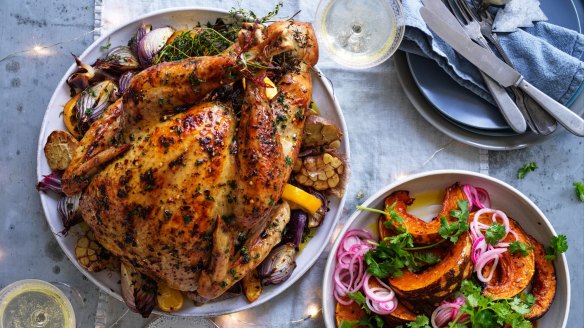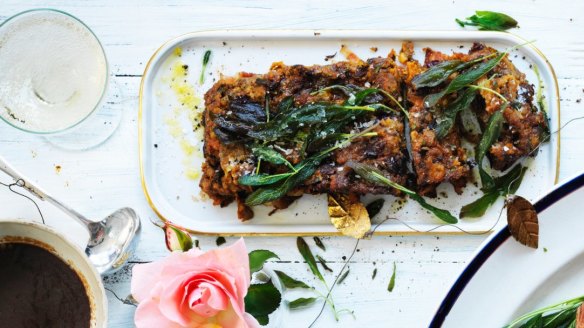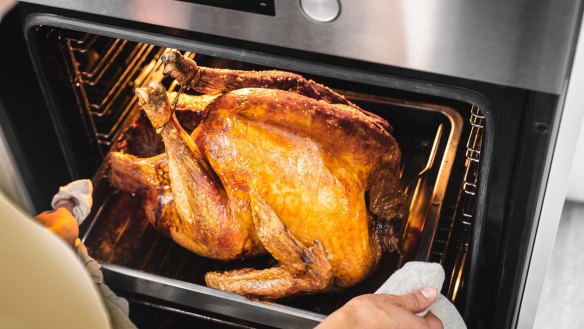How to brine and roast a Christmas turkey perfectly

Over the years turkey has gone from proud centrepiece of the festive table to being almost overlooked as an option. I hear people say, "it's too dry", or "it's not worth the effort", which saddens me.
As an American, I've either had or cooked a turkey at least once a year for most of my life. Not all were excellent but I've eaten some truly memorable birds and learnt a lot about cooking this festive fowl along the way.
Here, then, is my foolproof, hard-won advice on how to cook a juicy bird that you can be proud of. Consider this my petition to encourage you to give turkey another try.
To brine or not to brine?
The short answer is yes, you definitely need to brine a turkey. Turkeys are naturally lean and because they are quite large, it's really difficult to cook them through without the meat becoming tough. The definition of brine is water that has been strongly saturated with salt.
The thought of flipping a really large hot bird that is coated in butter sounds both dangerous and messy.
You will hear people talk about "dry brines", which given the absence of water no longer makes that a brine, to my mind. Instead you are just seasoning the bird a day or two in advance. This is a worthy step and at a minimum it's what you should do, but I see a proper brine as an opportunity to add flavour, moisture and tenderisation.
At its most basic, a brine is a mixture of water and salt, but from there you can add citrus, apples for sweetness, onions, garlic, spices, brown sugar, bay leaves – anything you think will enhance the flavour of your bird.
While that turkey sits in the brine over the course of 24 hours, the salt will season the meat throughout, the water will keep it moist, and sweeteners will be absorbed, helping you achieve a beautiful burnished skin.
The specifics
My basic poultry brine should cover any bird up to about 6kg. Anything over 6kg is a little too massive for my liking (and my fridge). If I'm cooking turkey for lots of people, I prefer to cook two smaller birds rather than one really large one.
Basic poultry brine
- 4 litres water
- 200g sea salt (5% of the volume of water)
- 100g brown sugar (2.5% of the volume of water)
For turkey, I like to add a sliced onion, a can of apple cider, some black peppercorns and lots of herbs such a bunch of thyme, a bunch of sage, a few bay leaves and a few sprigs of rosemary.
Boil 1 litre of the water with all of the salt and sugar to dissolve, then combine with the remaining cold water and aromatics. This should be fully chilled before submerging your bird in it.
Place the bird into a large container, such as a large stock pot, and pour the cold brine over it. Use a plate to weight the turkey down and keep it submerged.
If your turkey is too big to fit in your fridge, you'll need an Esky. The bird can be placed in a large brine bag with the brine, sealed and kept in the Esky over ice overnight. Or you can put your stock pot in the laundry sink and fill the sink with ice. Keep the turkey in the brine for a full 24 hours.

Should I stuff the turkey?
Yes! But not with stuffing. Although stuffing is my absolute favourite side dish, it should not be cooked inside the bird. Instead, make the stuffing and bake it in a baking dish while the bird rests.
The reason for cooking them separately is that you want the meat to cook evenly. By filling the cavity of the bird with a dense bread mix, you are actually slowing down the cooking on the inside of the bird. Think about it. By the time that stuffing heats through and then starts cooking, the meat on the outside of the bird will already be well done. This is not what you want.
Instead, loosely fill the cavity with sliced citrus and more herbs such as sage and fresh bay leaves. The aroma of those steaming herbs and citrus will not only perfume your bird but will contribute to a very delicious gravy (see recipe below).
Low and slow or hot and fast?
You've brined and filled your turkey with herbs and it's ready for the oven. But first, there's a crucial step towards a moist and delicious turkey that I suspect gets overlooked by cooks everywhere, and that's bringing the bird to room temperature before roasting.
To quell your fears, a well-brined, healthy turkey will not spontaneously become infected with unhealthy levels of bacteria in the time it is sitting on your bench waiting to be cooked (although I should say, as per good food safety practice, this period should never extend past 3 hours).
The other misunderstanding is that bringing it to room temperature can happen in 15 minutes. It may take an hour or more to remove that harsh chill from a large bird so it feels just gently cool to the touch.
Pat it very dry before putting it in the roasting pan, on a roasting rack, breast side up. Just before popping it in the oven, brush it with some melted butter all over the exterior.
I don't subscribe to theories about cooking large turkeys breast side down at first, as the thought of flipping a really large hot bird that is coated in butter sounds both dangerous and messy and I will almost certainly tear the beautiful skin, which I want to be intact at the end.

As for oven temperature, I like to start cooking the bird at 180C fan-forced (200C conventional) for about the first 15 minutes and then drop to a medium temperature of 155C fan-forced (175C conventional). A good rule of thumb is you should plan to cook your turkey 12 minutes for every 500g in size. Turkeys usually range from 4kg-8kg, so this total cooking time can vary from 1.5 hours to 3 hours. You will need a meat thermometer for the most accurate results.
To test whether it is cooked, measure near (but not at) the bone in the thickest part of the thigh and at the thickest part of the breast. The ideal temperature is 70C.
While your bird is roasting, you should baste it with melted butter every 20 minutes or so. I will melt 200g of butter and tie up more "hard herbs" such as thyme and rosemary to use as my basting brush. Feel free to also use a turkey baster or a spoon to scoop up the juices from the pan as it cooks and pour those over the bird.
It's cooked. Now what?
Your beautiful roast turkey is out of the oven and it's looking gorgeous. You must resist the urge to slice the bird for at least 30 minutes but longer if your bird is closer to 6kg-8kg.
Just as you took the time to take the chill off your bird before putting it in the oven, you must now pause to let the bird to cool slightly so it goes from being steaming hot to warm to the touch. This allows all those hot juices to redistribute and settle within the meat, rather than on your carving board (although you will have some of those and they should be poured into the gravy), resulting in juicier slices for all.
How to make gravy
I think I've been in Australia long enough to immediately think of that Paul Kelly song every time the subject of gravy comes up.
The first step is to make a simple turkey stock. I ask my butcher for a couple of extra turkey necks or wings and giblets, which I roast in the oven until they are deeply golden. Then I add them to a pot with a piece of onion, carrot, celery and a bay leaf and cover with cold water. I slowly simmer these for 2 hours, strain and skim off and discard any fat. This is half of your gravy equation. The other half comes from the pan juices of your roasted turkey, so this gravy must be made while your turkey rests.
Remove your bird from its roasting tray and set it aside on a carving board loosely covered with foil. Remove the roasting rack and pour all of the juices into a fat separator or measuring jug. Try to skim and discard most but not all of the fat.
Take the roasting tray and plonk it back on the stovetop over a low flame. Scoop a large spoonful of the leftover fat into the tray and then add 2-3 heaped tablespoons of plain flour. Stir the flour into the fat in the pan and use a rubber spatula or wooden spoon to scrape up any brown bits from the pan. Taste the pan drippings in your jug, if they are very salty, add only half into the roasting pan, whisking as you go, if not, add them all in.
Finally, add a cup or two of the turkey stock, whisk and allow this to come to a simmer and thicken. You can add a cup of liquid for every spoonful of flour so adjust accordingly and make as much as you like.
For thicker gravy, simmer it until it has reduced to your liking. You shouldn't need to add seasoning but like everything, give it a taste and adjust if necessary. You can add freshly cracked black pepper or a squeeze or lemon juice to brighten it, should you wish. Serve this really hot with the carved turkey.
I wonder if I've convinced you, dear reader, to consider bringing the turkey back to the table? I really do hope so.
The best recipes from Australia's leading chefs straight to your inbox.
Sign up- More:
- How to
